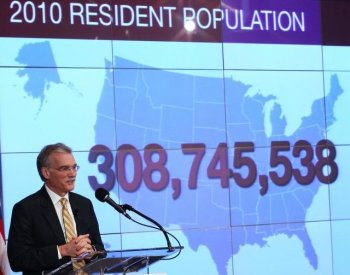WASHINGTON—Robert M. Groves said the 2010 census was very accurate—probably more accurate than the 2000 census. He is director of the U.S. Census Bureau and was speaking at a press conference on Wednesday Jan 12. Pleased with the results, Groves said his agency is moving to the next phase of preparing data for the states to use for redistricting.
From February to the end of March, the bureau will release block level data, which will enable state officials to do congressional and legislative redistricting. Almost immediately thereafter, the general public will have access to the same data that will be published on the census website.
April 1 was “Census Day,” when the country attempted to answer the question, “How many people lived in the United States on April 1, 2010?
The official count was 308,745,538. The country grew by 9.7 percent compared to 2000. Growth was highest in the South (14.3 percent) and West (13.8 percent), and less strong in the Northeast (3.2 percent) and Midwest (3.9 percent).
The growth rate for the past decade of 9.7 percent was less than the previous decade, 1990-2000, when growth was 13.2 percent.
Groves discussed why the bureau is so pleased by the national count of 2010. The nation’s best demographers and statisticians tried to estimate the national population, using birth and death records and estimates of in-migration and out-migration. The bureau took multiple estimates and arrayed them from the least (305.7M) to the most (312.7M). The count fell almost exactly in the middle of the demographer’s estimates, being only 0.09 percent different.
In other words, the census and the demographer’s population numbers are virtually the same.
Another method used to corroborate the official estimate starts from the 2000 census count and using external data, such as vital statistics and migration, estimates the population count 10 years in the future. Again, the estimate was virtually the same as the 2010 census result.
Groves said that the percentage of households in the 2010 census returning the forms by mail—74 percent—was a little better than the 2000 census, which required some households to return the long form.
Finally, perhaps the most reassuring evidence that the census numbers are good lies in the outcomes of post-enumeration surveys. Groves said that Census conducts a large sample survey of households where “very, very highly skilled interviewers” ask detailed questions concerning who lived at the household on April 1. This sample follow-up was “a key tool” to ascertain whether someone was missed, or counted twice, or incorrectly described.
The final results of the post-enumeration surveys won’t be available until 2012, but preliminary results are showing some good signs, Groves said. The percentage of household units that were verified in the 2010 census is higher than the 2000 census. The percentage of households that were found to be duplicates is lower in 2010 compared to 2000.
Groves said that when we see various independent estimates pointing in the same direction, we can take comfort in the results.
Should we regard the official count as slightly less than the true national population number because, undoubtedly, some people are missed and not counted? Groves disagreed. He answered, “We know that in prior decades, we counted some people twice. … So, a bigger number is not necessarily the best number.”
He said the post-enumeration survey of the 2000 census found “a small net over count. It is completely conceivable that this could happen again.” Groves said they make considerable efforts to reduce undercounts. Whenever you do that, “you run the risk of counting people twice.”
Next: The Census Bureau Results
From February to the end of March, the bureau will release block level data, which will enable state officials to do congressional and legislative redistricting. Almost immediately thereafter, the general public will have access to the same data that will be published on the census website.
April 1 was “Census Day,” when the country attempted to answer the question, “How many people lived in the United States on April 1, 2010?
The official count was 308,745,538. The country grew by 9.7 percent compared to 2000. Growth was highest in the South (14.3 percent) and West (13.8 percent), and less strong in the Northeast (3.2 percent) and Midwest (3.9 percent).
The growth rate for the past decade of 9.7 percent was less than the previous decade, 1990-2000, when growth was 13.2 percent.
Corroborating the 2010 Census
Groves discussed why the bureau is so pleased by the national count of 2010. The nation’s best demographers and statisticians tried to estimate the national population, using birth and death records and estimates of in-migration and out-migration. The bureau took multiple estimates and arrayed them from the least (305.7M) to the most (312.7M). The count fell almost exactly in the middle of the demographer’s estimates, being only 0.09 percent different.
In other words, the census and the demographer’s population numbers are virtually the same.
Another method used to corroborate the official estimate starts from the 2000 census count and using external data, such as vital statistics and migration, estimates the population count 10 years in the future. Again, the estimate was virtually the same as the 2010 census result.
Groves said that the percentage of households in the 2010 census returning the forms by mail—74 percent—was a little better than the 2000 census, which required some households to return the long form.
Finally, perhaps the most reassuring evidence that the census numbers are good lies in the outcomes of post-enumeration surveys. Groves said that Census conducts a large sample survey of households where “very, very highly skilled interviewers” ask detailed questions concerning who lived at the household on April 1. This sample follow-up was “a key tool” to ascertain whether someone was missed, or counted twice, or incorrectly described.
The final results of the post-enumeration surveys won’t be available until 2012, but preliminary results are showing some good signs, Groves said. The percentage of household units that were verified in the 2010 census is higher than the 2000 census. The percentage of households that were found to be duplicates is lower in 2010 compared to 2000.
Groves said that when we see various independent estimates pointing in the same direction, we can take comfort in the results.
Should we regard the official count as slightly less than the true national population number because, undoubtedly, some people are missed and not counted? Groves disagreed. He answered, “We know that in prior decades, we counted some people twice. … So, a bigger number is not necessarily the best number.”
He said the post-enumeration survey of the 2000 census found “a small net over count. It is completely conceivable that this could happen again.” Groves said they make considerable efforts to reduce undercounts. Whenever you do that, “you run the risk of counting people twice.”
Next: The Census Bureau Results
Results
The Census Bureau compiles statistics to fulfill the fundamental, constitutionally-mandated purpose of the census, which is apportionment—determining how many representatives each state is entitled to.
Supreme Court decisions handed down in the 1960s and the 1965 Voting Rights Act gave birth to the “one-person, one vote” principle, and to requiring congressional districts and state legislative districts be made “as equal in population as practically possible.” Detailed census information enables state officials to realign congressional and state legislative districts in their states.
The 2010 census found that the most populous states are California (37.2M), Texas (25.1M), New York (19.4M), Florida (18.8M), and Illinois (12.8M). Least populous states are Wyoming, Vermont, North Dakota, Alaska, and South Dakota, which range from 563,626 to 814,180.
Last month, the bureau released official state population counts and the national count. A shift in seats will impact 18 states.
Gaining states were Arizona, Florida (gained 2), Georgia, Nevada, South Carolina, Texas (gained 4), Utah, and Washington. The states losing representatives are Illinois, Iowa, Louisiana, Massachusetts, Michigan, Missouri, New Jersey, New York (lost 2), Ohio (lost 2), and Pennsylvania.
By no later than April 1, the Census Bureau must provide, for all states, detailed population counts within each state that can be used by local officials for redistricting of congressional districts and legislative districts.
The Census Bureau will provide at the block level, state population counts by race and Hispanic or Latino categories. Additionally, Census will provide in this dataset, state housing unit counts by occupancy status. Thus, at the block level, vacancy rates across the country will be able to be computed.
This information is released during the February-March period to the state officials designated by law to carry out redistricting as soon as it becomes ready. Within 24 hours, the data goes to the general public on American FactFinder (AFF).
Using the data-access tool AFF, data users will have access to information about their communities, the economy, and society. Users will be able to access the data and create their own reports.
On Jan. 18, the bureau will hold a Web conference of American FactFinder, and show its new improved version, explaining new tools and easier access to Census Bureau statistics.
During this period, February through March, the bureau will also be releasing results from the American Community Survey (ACS), which is not a total enumeration like the census, but a probability sample, drawing from every county in the nation, of 250,000 household addresses per month. The ACS complements the decennial census, which is restricted to asking just a few questions. The ACS provides socio-economic data, education, and travel to work patterns, language spoken at home, military service, and more. Information from the survey helps determine how more than $400 billion in federal and state funds are distributed each year.
Supreme Court decisions handed down in the 1960s and the 1965 Voting Rights Act gave birth to the “one-person, one vote” principle, and to requiring congressional districts and state legislative districts be made “as equal in population as practically possible.” Detailed census information enables state officials to realign congressional and state legislative districts in their states.
The 2010 census found that the most populous states are California (37.2M), Texas (25.1M), New York (19.4M), Florida (18.8M), and Illinois (12.8M). Least populous states are Wyoming, Vermont, North Dakota, Alaska, and South Dakota, which range from 563,626 to 814,180.
Last month, the bureau released official state population counts and the national count. A shift in seats will impact 18 states.
Gaining states were Arizona, Florida (gained 2), Georgia, Nevada, South Carolina, Texas (gained 4), Utah, and Washington. The states losing representatives are Illinois, Iowa, Louisiana, Massachusetts, Michigan, Missouri, New Jersey, New York (lost 2), Ohio (lost 2), and Pennsylvania.
Next Phase: Redistricting and Future Products
By no later than April 1, the Census Bureau must provide, for all states, detailed population counts within each state that can be used by local officials for redistricting of congressional districts and legislative districts.
The Census Bureau will provide at the block level, state population counts by race and Hispanic or Latino categories. Additionally, Census will provide in this dataset, state housing unit counts by occupancy status. Thus, at the block level, vacancy rates across the country will be able to be computed.
This information is released during the February-March period to the state officials designated by law to carry out redistricting as soon as it becomes ready. Within 24 hours, the data goes to the general public on American FactFinder (AFF).
Using the data-access tool AFF, data users will have access to information about their communities, the economy, and society. Users will be able to access the data and create their own reports.
On Jan. 18, the bureau will hold a Web conference of American FactFinder, and show its new improved version, explaining new tools and easier access to Census Bureau statistics.
During this period, February through March, the bureau will also be releasing results from the American Community Survey (ACS), which is not a total enumeration like the census, but a probability sample, drawing from every county in the nation, of 250,000 household addresses per month. The ACS complements the decennial census, which is restricted to asking just a few questions. The ACS provides socio-economic data, education, and travel to work patterns, language spoken at home, military service, and more. Information from the survey helps determine how more than $400 billion in federal and state funds are distributed each year.






